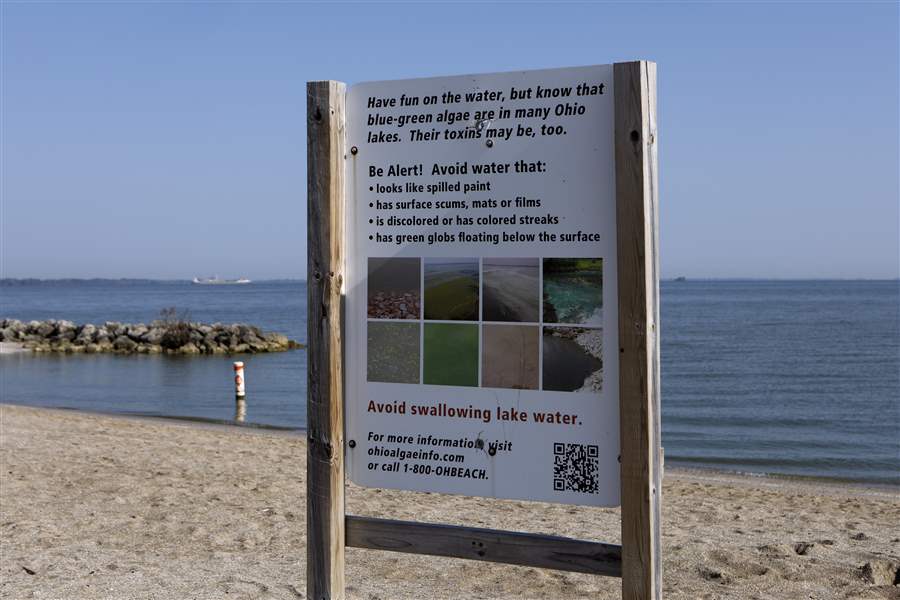
Fate of western Lake Erie under new governors uncertain
11/8/2018
An executive order by Ohio Gov. John Kasich had called for the Ohio Department of Agriculture declare eight watersheds in the Maumee River basin as “distressed,” but that plan has been put on hold until at least mid-February by a state task force that reports to the Ohio Soil and Water Conservation Commission.
The Blade/Andy Morrison
Buy This Image
For now, it’s unclear what will happen to western Lake Erie once Gretchen Whitmer and Mike DeWine are sworn in as governors of Michigan and Ohio, respectively.
But those who track algal blooms see great potential for a fresh start and the chance for more bipartisan cooperation.
Gone will be the shadows of the Flint water crisis that have hung over Michigan Gov. Rick Snyder, a Republican who took the brunt of criticism for that high-profile disaster.
Ms. Whitmer, a Democrat, has vowed a new era. The day after her election victory, she named Dr. Mona Hanna-Attisha — the pediatrician who convinced the world that Flint’s massive lead problem was real — to her transition team.
And several people interviewed said it is an oversimplification to think of Mr. DeWine’s election as merely a hand-off from one Republican to another, given his record of occasionally breaking party lines on environmental issues.
But it’s unknown what that means for Gov. John Kasich’s executive order to have the Ohio Department of Agriculture declare eight watersheds in the Maumee River basin as “distressed” because of algae-growing nutrients, making them subject to tougher oversight.
The plan has been put on hold until at least mid-February by a state task force that reports to the Ohio Soil and Water Conservation Commission.
“There needs to be more action to eliminate runoff, both agricultural and otherwise,” a statement attributed to Mr. DeWine said. “My commitment is that, as governor, I will bring people together from all sides to make sure we chart a path forward that can gain as much consensus as possible.”
Mr. DeWine also said in the statement that he continues to support plans for a Lake Erie bond initiative proposed by Ohio Sen. Randy Gardner (R., Bowling Green).
“Mike DeWine is a smart guy. He knows that there are no simple solutions to complex problems, and fixing Lake Erie is extremely complex,” Joe Cornely, the state farm bureau’s spokesman, said.
Chris Winslow, director of Ohio Sea Grant and Ohio State University’s Stone Laboratory, said he hopes the DeWine administration continues to fund the Ohio Department of Education’s Harmful Algal Bloom Research Initiative at $2 million or more a year. That commitment from the Kasich administration began in 2015, in response to Toledo’s 2014 algae-induced water crisis.
University of Toledo Lake Erie Center Director Tom Bridgeman agreed. He said he hopes “that policies under the new administration will accelerate the implementation of watershed practices that will reduce the runoff of nutrients into Lake Erie that fuel the blooms in the first place.”
“Given that water quality has been regionally a bipartisan issue, I would be very disappointed if the current efforts to support research into effective land use and algal bloom management were discontinued,” said George Bullerjahn, director of Bowling Green State University’s newly created Lake Erie Center for Fresh Waters and Human Health.
The distressed watershed approach is seen as a softer version of a more comprehensive cleanup strategy known as a Total Maximum Daily Load, or TMDL, program.
But Howard Learner, Environmental Law & Policy Center executive director, said they don’t have to be in conflict with one another. Though the ELPC will continue to push for the more aggressive cleanup strategy, he said the distressed watershed approach could be used as part of a framework for an eventual TMDL.
“This is an opportunity for practical solutions that aren’t partisan in any way but get to the heart of what all Ohioans care about, which is safe, clean water,” Mr. Learner said. “Dealing with the distressed waters program is a mean to that end. There may be a combination of approaches.”
Frank Szollosi, National Wildlife Federation regional outreach manger, said “all of the durable conservation victories in our country have been bipartisan.”
“The National Wildlife Federation is excited to get to work with both Mike DeWine and Gretchen Whitmer to build solutions for the western basin of Lake Erie and the Great Lakes themselves,” he said. “They're both new. They have a chance to approach this in a bipartisan way. It could be a very exciting time for the lake.”
Several others were upbeat, including Sarah Spence, Ohio Environmental Council government affairs director.
“There is no doubt Governor-elect DeWine cares about having a healthy Lake Erie," she said.
Activists such as Sandy Bihn, Lake Erie Waterkeeper executive director, remain concerned about the increasing number of cows in the western Lake Erie watershed — and what the impact of their manure will have on the lake.
Pam Taylor, of Environmentally Concerned Citizens of South Central Michigan, said the region needs “the scientific accountability and enforcement of the Clean Water Act to fix the algae problem, not Ohio's distressed designation that has been such a disaster for Grand Lake St. Marys.”
Mike Ferner, Advocates for a Clean Lake Erie coordinator, didn’t share the optimism of others.
“Lake Erie has suffered under both political parties because politicians refuse to challenge the Farm Bureau's ability to dictate policies that benefit industrial agriculture,” Mr. Ferner said. “A DeWine administration will continue that corrupt tradition until enough people raise enough hell to stop factory farm operators from using the lake as a free toilet while we pay the bill.”